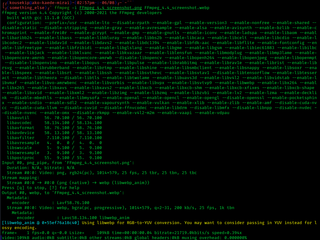
FFmpeg is a free and open-source software project consisting of a large suite of libraries and programs for handling video, audio, and other multimedia files and streams. At its core is the FFmpeg program itself, designed for command-line-based processing of video and audio files. It is widely used for format transcoding, basic editing, video scaling, video post-production effects and standards compliance.

VideoLAN is a non-profit organization which develops software for playing video and other media formats. It originally developed two programs for media streaming, VideoLAN Client (VLC) and VideoLAN Server (VLS), but most of the features of VLS have been incorporated into VLC, with the result renamed VLC media player.
RealVideo is a suite of proprietary video compression formats developed by RealNetworks – the specific format changes with the version. It was first released in 1997 and as of 2008 was at version 10. RealVideo is supported on many platforms, including Windows, Mac, Linux, Solaris, and several mobile phones.

VirtualDub is a free and open-source video capture and video processing utility for Microsoft Windows written by Avery Lee. It is designed to process linear video streams, including filtering and recompression. It uses AVI container format to store captured video. The first version of VirtualDub, written for Windows 95, to be released on SourceForge was uploaded on August 20, 2000.

VLC media player is a free and open-source, portable, cross-platform media player software and streaming media server developed by the VideoLAN project. VLC is available for desktop operating systems and mobile platforms, such as Android, iOS, iPadOS, Windows 10 Mobile, and Windows Phone. VLC is also available on digital distribution platforms such as Apple's App Store, Google Play, and Microsoft Store.

ffdshow is an open-source unmaintained codec library that is mainly used for decoding of video in the MPEG-4 ASP and H.264/MPEG-4 AVC video formats, but it supports numerous other video and audio formats as well. It is free software released under GNU General Public License 2.0, runs on Windows, and is implemented as a Video for Windows (VFW) codec and a DirectShow filter.
x264 is a free and open-source software library and a command-line utility developed by VideoLAN for encoding video streams into the H.264/MPEG-4 AVC video coding format. It is released under the terms of the GNU General Public License.
Flash Video is a container file format used to deliver digital video content over the Internet using Adobe Flash Player version 6 and newer. Flash Video content may also be embedded within SWF files. There are two different Flash Video file formats: FLV and F4V. The audio and video data within FLV files are encoded in the same way as SWF files. The F4V file format is based on the ISO base media file format, starting with Flash Player 9 update 3. Both formats are supported in Adobe Flash Player and developed by Adobe Systems. FLV was originally developed by Macromedia. In the early 2000s, Flash Video was the de facto standard for web-based streaming video. Users include Hulu, VEVO, Yahoo! Video, metacafe, Reuters.com, and many other news providers.
Pirated movie release types are the different types of pirated movies and television series that end up on the Internet. They vary wildly in rarity and quality due to the different sources and methods used for acquiring the video content, in addition to encoding formats. Pirated movie releases may be derived from cams, which have distinctly low quality; screener and workprint discs or digital distribution copies (DDC), telecine copies from analog reels, video on demand (VOD) or TV recordings, and DVD and Blu-ray rips. They are seen in P2P networks, pirated websites and video sharing websites such as YouTube and Dailymotion.

Microsoft Expression Encoder is a transcoding and non-linear video editing software application for Microsoft Windows. It can create video streams for distribution via Microsoft Silverlight. This utility is created to record the screen for various purposes like YouTube, Twitch, Sharing etc.
Asao is a proprietary single-channel (mono) codec and compression format optimized for low-bitrate transmission of audio, developed by Nellymoser Inc.

VP8 is an open and royalty-free video compression format created by On2 Technologies as a successor to VP7 and owned by Google from 2010.
The HTML5 specification introduced the video element for the purpose of playing videos, partially replacing the object element. HTML5 video is intended by its creators to become the new standard way to show video on the web, instead of the previous de facto standard of using the proprietary Adobe Flash plugin, though early adoption was hampered by lack of agreement as to which video coding formats and audio coding formats should be supported in web browsers. As of 2020, HTML5 video is the only widely supported video playback technology in modern browsers, with the Flash plugin being phased out.
The Helix Universal Media Server was a product developed by RealNetworks and originates from the first streaming media server originally developed by Progressive Networks in 1994. It supported a variety of streaming media delivery transports including MPEG-DASH RTMP (flash), RTSP (standard), HTTP Live Streaming (HLS), Microsoft Silverlight and HTTP Progressive Download enabling mobile phone OS and PC OS media client delivery.

Libav is an abandoned free software project, forked from FFmpeg in 2011, that produces libraries and programs for handling multimedia data.

Freeseer is a cross-platform screencasting application suite released as free and open-source software. Freeseer is a project of the Free and Open Source Software Learning Centre (FOSSLC), a not-for-profit organization.
OpenH264 is a free software library for real-time encoding and decoding video streams in the H.264/MPEG-4 AVC format. It is released under the terms of the Simplified BSD License.
Nvidia NVENC is a feature in Nvidia graphics cards that performs video encoding, offloading this compute-intensive task from the CPU to a dedicated part of the GPU. It was introduced with the Kepler-based GeForce 600 series in March 2012.
AOMedia Video 1 (AV1) is an open, royalty-free video coding format initially designed for video transmissions over the Internet. It was developed as a successor to VP9 by the Alliance for Open Media (AOMedia), a consortium founded in 2015 that includes semiconductor firms, video on demand providers, video content producers, software development companies and web browser vendors. The AV1 bitstream specification includes a reference video codec. In 2018 Facebook conducted testing that approximates real world conditions, the AV1 reference encoder achieved 34%, 46.2% and 50.3% higher data compression than libvpx-vp9, x264 high profile, and x264 main profile respectively.
Streamlabs is a live streaming software that integrates Open Broadcaster Software with viewer interactions, chat management, and tip donations. Streamlabs uses OBS for media streaming and Electron for user interface. Streamlabs distributes their user's content over platforms such as Twitch, YouTube Live, and Facebook Live.








